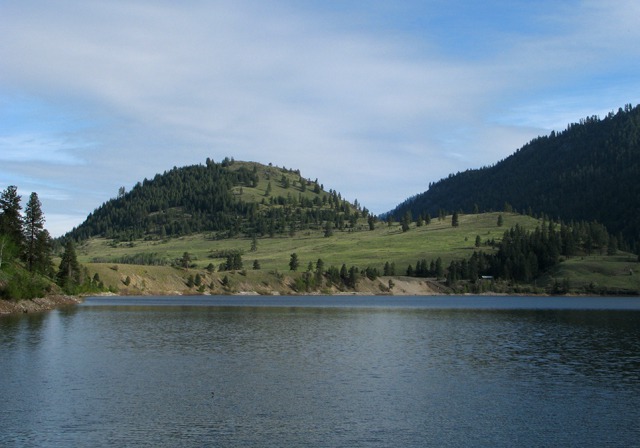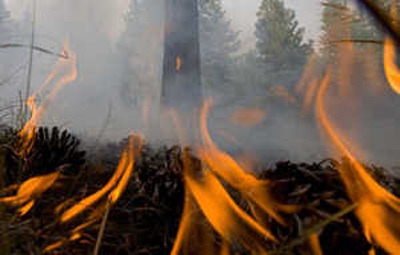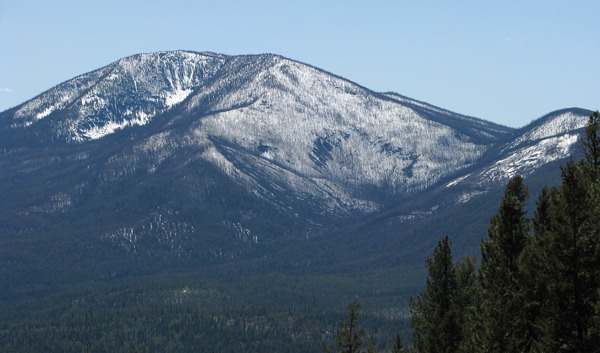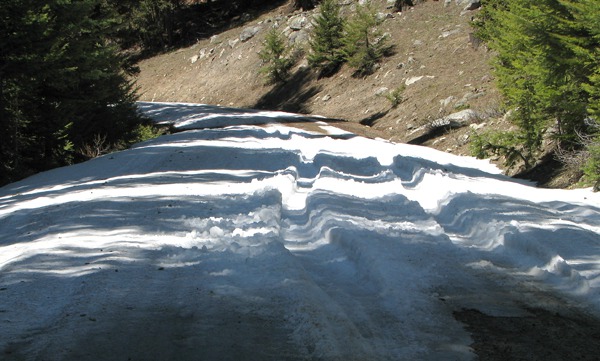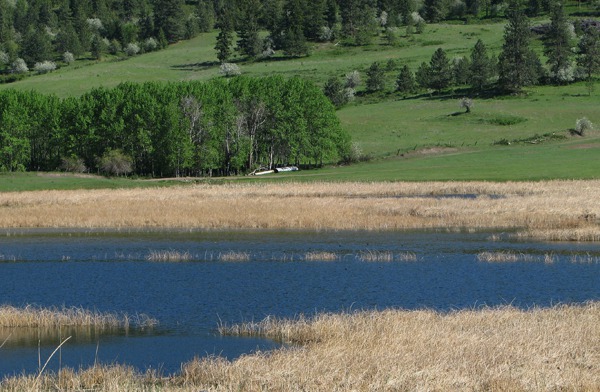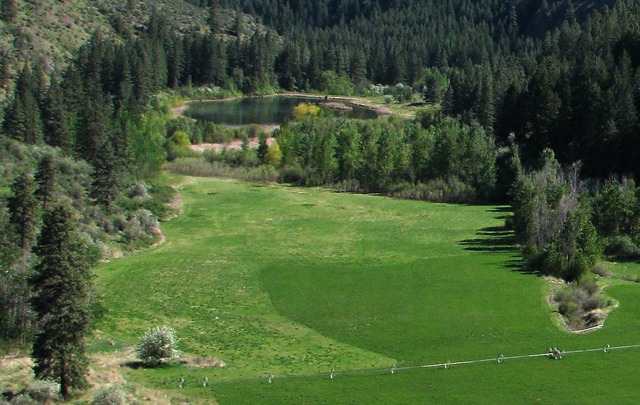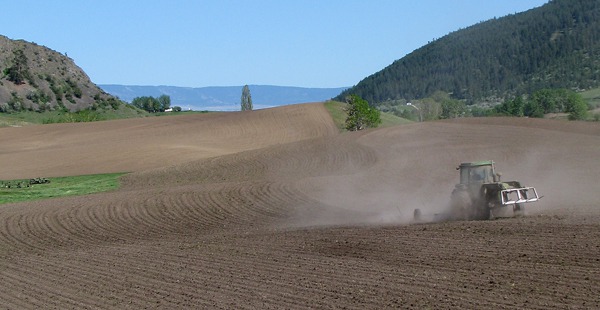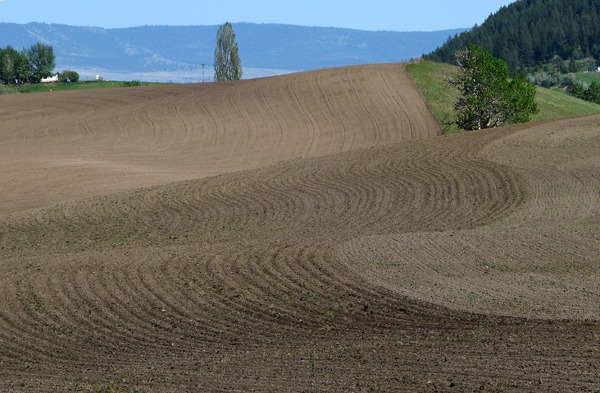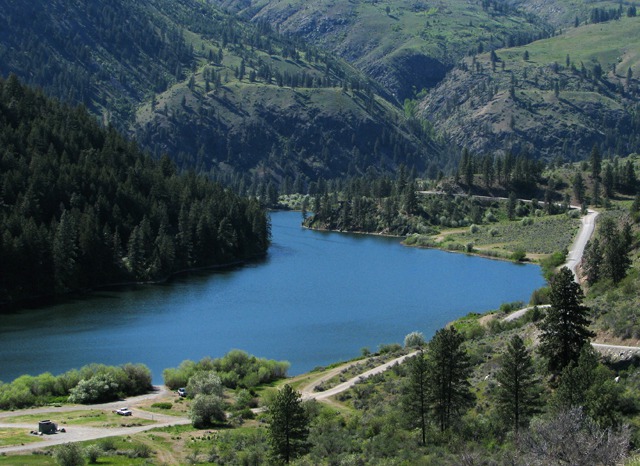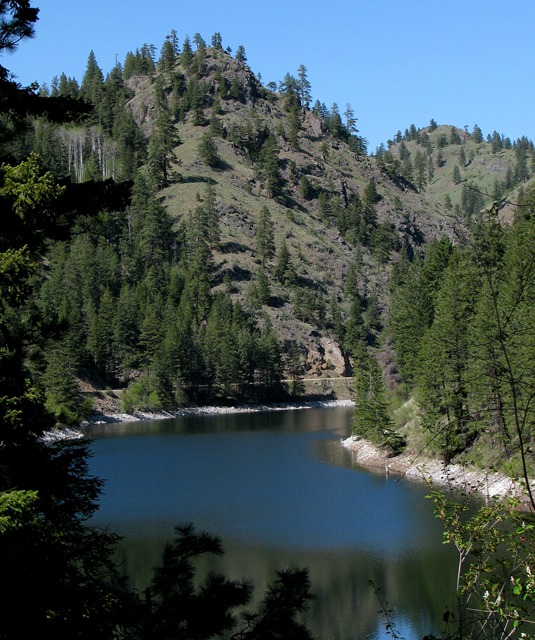It's late May, and we're spending a week with long-time friends, Gary and Deb, at Lake Conconully in Okanogan Country in Washington, where Gary had been going since he was a child. They parked their fifth-wheel in the campground overlooking the lake; we were settled in nearby in the resort motel and had one trip around the areas with Gary and Deb under our belts. Now we were ready for a second day trip around the area.
"Let's go explore the mountains," Brian suggests. "There are some cute little towns like Twisp on the eastern side of the Cascades." He had lived in Seattle for a dozen years and knows the Cascades area. So off we go on Forest Service road 37 to the west of Conconully and into the Okanogan National Forest. The sun is warm and the sky blue, and Leesha is eager for a ride, a chance to get out of the motel room. We're bouncing along through the woods, and the story of forest ecology and management just unfolds around us. The Forest Service has been busy cutting underbrush and excess trees and burning up slash, working to restore the natural forest succession process. “So,” wonders Leesha. “What in the world is the natural forest succession process?” As it happens, Brian and I know quite a bit about forests – he fought fires, worked on forest fuel management crews, wrote National Forest Environmental Impact Statements, and worked trail crews, all for the U.S. Forest Service. I participated in an environmental assessment on the Nature Conservancy’s Ten Sleep Preserve in Wyoming. We surveyed the results of a prescribed burn, and we evaluated a potential burn site. Forest researchers have studied historical photographs and documents describing these huge Western forests at the time of European settlement. The forests were considerably different then -- vast open meadows of grasses, flowers, and shrubs; trees in a variety of age classes from seedlings to mature monarchs hundreds of feet high, more wildlife, and frequent forest and range fires. Historically frequent fires crept through the litter on the forest floor -- burning layers of pine needles, dry leaves, dead branches, brush, and any crowded seedling trees. The older trees developed fire-resistant bark as they aged. These fires cleaned out the forest, preventing the build-up of fuel on the forest floor, nourishing the soil with the resulting ash, and providing perfect germination conditions for plants that required fire in order to sprout. The forest ecosystem depended on these fires. Because the fires were frequent, fuel didn’t get a chance to build up on the forest floor, and little trees didn’t get a chance to grow right next to big ones – providing perfect ladders for fire to climb to the top of the bigger trees. European settlers clear-cut the forests, using the timber to build railroads, homes, and provide fuel for mines and other industrial enterprises. This practice resulted in re-growth of trees all the same age and size. Forest policy became one of immediate fire suppression and clear cutting of timber. After decades of these policies, forests all over the United States were vulnerable to huge explosive fires -- too many trees too close together and too many trees of the same age and size resulted in perfect conditions for raging "crown" fires such as the ones in Yellowstone Park in 1989. A crown fire roars through the tops (crowns) of trees and is the most destructive form of forest fire. Like with many things, the longer you let the problem go, the harder it is to rectify. Over time, up to 100 tons of fire fuel per acre can accumulate. So then, even trying to solve the problem with controlled fires becomes a problem. According to a June 25, 2003 website article on the topic by Northern Arizona University, "Forest Fire in the American Southwest," "Extreme fuel loads make prescribed burning not only risky in terms of potential for escape, but often unintentionally destructive. Consumption of large amounts of fuel generates large amounts of heat." I remember watching the Jasper fire near Jewel Cave National Monument in the Black Hills literally explode, sending columns of thick black smoke tens of thousands of feet into the atmosphere. That fire, the largest in the Black Hills since European settlement, burned 83,508 acres and burned from 24 August 2000 to 25 September 2000. The Forest Service provides all the details at www.fs.fed.us/r2/blackhills/fire/history/Jasper/index.shtml Leesha just looks at us – so many big words and so much fire. “What does it all mean for a cat or other creature in the woods?” So just what is the "natural order of things" in a forest? Foresters now know fire is absolutely vital to the health and growth of the forest ecosystem, but the question is, "What kind of fire?" 1. More frequent creeping fires remove the forest litter, reducing fuel build-up and preventing serious “crown fires” like the ones that burned over half of Yellowstone Park. 2. Sapling thickets generate particularly large amounts of fuel, creating ideal conditions for laddering where the fire leaves the ground and goes up the tree trunks and into the branches, and thereby increasing the probability of crown fires in the larger pines. 3. By burning forest litter, these fires release nutrients back into the soil. Animals such as deer and elk roll in the ashes to remove ticks. 4. Surface fires also spur the germination of plants, especially fire-cycle conifers such as the giant sequoia, the lodge pole pine, and the jack pine. The cones of these species have to be exposed to extreme heat before they release seeds. The reason is that the seeds are small and have to land on bare dirt before they can germinate. If they land in forest litter, they won't germinate. Many flowers and grasses are also fire-dependent for germination or require ash-rich soil to grow. 5. Such fires help reduce the number of pathogens and insects. Fire is the only effective "treatment" for pine beetles. 6. Surface fires create or help maintain habitat for animals such as deer, moose, elk, muskrat, woodcock, and quail by burning back or thinning sections of the forest. 7. Periodic fires open up sections of the forest canopy, creating an opening for smaller plants that need lots of sunlight to grow; this stimulates diversity in the forest ecosystem. After Cleanup Leesha could see that the “cleaned-up” forest was easier for a cat to walk through. She could find sun for basking and wood piles for hunting chipmunks, even though she only watched them, knowing she was too old and too slow to catch one. According to R. Neil Sampson in his article, "Experience with Fire and Fire Management in U.S. Forests and the Potential to Increase Carbon Stocks on Forest Land by Changing Practices," "The extent of historical fire is one indicator of how necessary fire has been to the ecology of the forests. By applying what is known about the fire regimes associated with different ecosystems, and using the best available estimates of the extent and location of pre-settlement ecosystems, Leenhouts (1998) estimated that pre-settlement fire must have averaged something on the order of 100-150 million acres a year. Nothing less could have shaped the ecosystems that emerged. Obviously, that number would have varied considerably from year to year, and was no doubt affected by long-term climate swings, but as an average, it is still pretty impressive. By comparison, if we see 5 or 6 million acres of fire today, we call it a major fire year. (www.sampsongroup.com/Papers/Fire%20Management,%20Biomass,%20and%20Carbon.pdf) The U.S. Forest Service has programs for Fuels Management geared toward reducing the risk of catastrophic fires by systematically reducing the fuel loads in the forests. Each national forest has a fuels management plan. Those programs have been greatly curtailed over the last 20 years by budget cuts and legal challenges. In many cases, areas where fuels management efforts were stopped by "environmental" lawsuits, fire subsequently destroyed the entire area. The irony is that now many times those amounts are spent on fire suppression efforts that might have been unnecessary had the fuels management programs been funded. Even with "prescribed burns" fuel hazard is only temporarily reduced because up to 2 tons per acre of fine fuels like needles and branches are normally dropped each year. Repeated burning is essential to remove these fire-created fuels and generally maintain a low fuel hazard. Slash cleanup is designed to replicate a naturally occurring surface fire. If a heavy duff area like the one above does catch fire, it can burn for months (even over the winter under the snow) creating lethal temperatures deeper than 8 inches in mineral soil on some sites. This effectively “kills” the soil – the microbes, plant roots, seeds, insects. (http://forestfire.nau.edu/fuelloads.htm) Frequent fires that burn off light layers of duff, on the other hand, maintain forest health. In the years following clean-up, grasses and flowers begin to grow in the increased sun and improved soil. You wouldn’t know this forest had been logged and burned only a year or two ago. As we drive up the road past spots where the brush and deadfall had been cleared, we think Leesha might want a stretch break. We stop the 4 Runner and open her door. Nothing doing. Odd, because she had readily jumped out on all the other stops. Then Louise spots a bear track near the edge of the road. How the Furry Purry knew there was a bear is anyone's guess. Wish we had her instincts. Just as the opened forest creates habitat for the chipmunk and bear, it also creates a feed bonanza for deer and elk. The small saplings that start to grow provide browse, and the grass and forbes that spring up when the duff layer is removed are full of rich protein. We, and Leesha, think it's a shame that the budget cuts the Forest Service and State Forestry agencies have experienced have allowed the forests to deteriorate to the point they have. And ironically, now hundreds of times as much as it would take to manage the forest are being spent annually on catastrophic fires once they start and gain momentum. Sounds silly, -- and sad. We continued toward Twisp, but there was plenty of snow higher up.
Discretion being the better part of walking out to help, after bucking a few moderate drifts, the snow became constant and was growing deeper, so we abandon the idea of getting to Twisp and headed back toward Lake Conconully. As we got further down into the valley, we encountered more of the pothole lakes we'd seen on our first day-trip around the lake.
After driving through a stretch of agricultural land, we reached one of the arms of Conconully once again. So we didn't "make" Twisp, but we had a great day. Louise, with photos by Brian Text and photos copyright -- Goin Mobyle LLC. 2008


